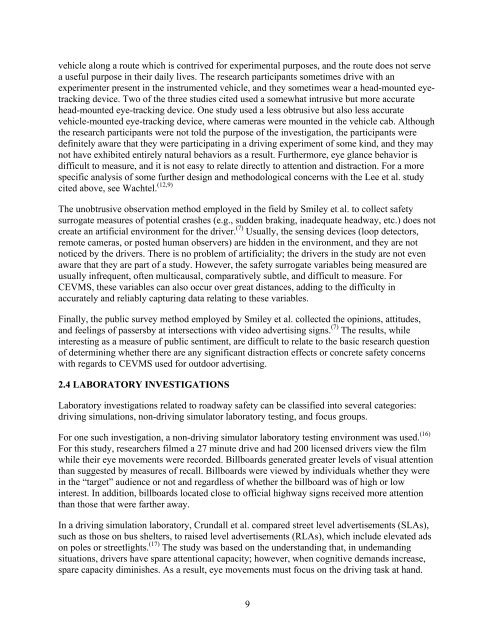The Effects of Commercial Electronic Variable Message Signs ...
The Effects of Commercial Electronic Variable Message Signs ...
The Effects of Commercial Electronic Variable Message Signs ...
Create successful ePaper yourself
Turn your PDF publications into a flip-book with our unique Google optimized e-Paper software.
vehicle along a route which is contrived for experimental purposes, and the route does not serve<br />
a useful purpose in their daily lives. <strong>The</strong> research participants sometimes drive with an<br />
experimenter present in the instrumented vehicle, and they sometimes wear a head-mounted eyetracking<br />
device. Two <strong>of</strong> the three studies cited used a somewhat intrusive but more accurate<br />
head-mounted eye-tracking device. One study used a less obtrusive but also less accurate<br />
vehicle-mounted eye-tracking device, where cameras were mounted in the vehicle cab. Although<br />
the research participants were not told the purpose <strong>of</strong> the investigation, the participants were<br />
definitely aware that they were participating in a driving experiment <strong>of</strong> some kind, and they may<br />
not have exhibited entirely natural behaviors as a result. Furthermore, eye glance behavior is<br />
difficult to measure, and it is not easy to relate directly to attention and distraction. For a more<br />
specific analysis <strong>of</strong> some further design and methodological concerns with the Lee et al. study<br />
cited above, see Wachtel. (12,9)<br />
<strong>The</strong> unobtrusive observation method employed in the field by Smiley et al. to collect safety<br />
surrogate measures <strong>of</strong> potential crashes (e.g., sudden braking, inadequate headway, etc.) does not<br />
create an artificial environment for the driver. (7) Usually, the sensing devices (loop detectors,<br />
remote cameras, or posted human observers) are hidden in the environment, and they are not<br />
noticed by the drivers. <strong>The</strong>re is no problem <strong>of</strong> artificiality; the drivers in the study are not even<br />
aware that they are part <strong>of</strong> a study. However, the safety surrogate variables being measured are<br />
usually infrequent, <strong>of</strong>ten multicausal, comparatively subtle, and difficult to measure. For<br />
CEVMS, these variables can also occur over great distances, adding to the difficulty in<br />
accurately and reliably capturing data relating to these variables.<br />
Finally, the public survey method employed by Smiley et al. collected the opinions, attitudes,<br />
and feelings <strong>of</strong> passersby at intersections with video advertising signs. (7) <strong>The</strong> results, while<br />
interesting as a measure <strong>of</strong> public sentiment, are difficult to relate to the basic research question<br />
<strong>of</strong> determining whether there are any significant distraction effects or concrete safety concerns<br />
with regards to CEVMS used for outdoor advertising.<br />
2.4 LABORATORY INVESTIGATIONS<br />
Laboratory investigations related to roadway safety can be classified into several categories:<br />
driving simulations, non-driving simulator laboratory testing, and focus groups.<br />
For one such investigation, a non-driving simulator laboratory testing environment was used. (16)<br />
For this study, researchers filmed a 27 minute drive and had 200 licensed drivers view the film<br />
while their eye movements were recorded. Billboards generated greater levels <strong>of</strong> visual attention<br />
than suggested by measures <strong>of</strong> recall. Billboards were viewed by individuals whether they were<br />
in the “target” audience or not and regardless <strong>of</strong> whether the billboard was <strong>of</strong> high or low<br />
interest. In addition, billboards located close to <strong>of</strong>ficial highway signs received more attention<br />
than those that were farther away.<br />
In a driving simulation laboratory, Crundall et al. compared street level advertisements (SLAs),<br />
such as those on bus shelters, to raised level advertisements (RLAs), which include elevated ads<br />
on poles or streetlights. (17) <strong>The</strong> study was based on the understanding that, in undemanding<br />
situations, drivers have spare attentional capacity; however, when cognitive demands increase,<br />
spare capacity diminishes. As a result, eye movements must focus on the driving task at hand.<br />
9

















